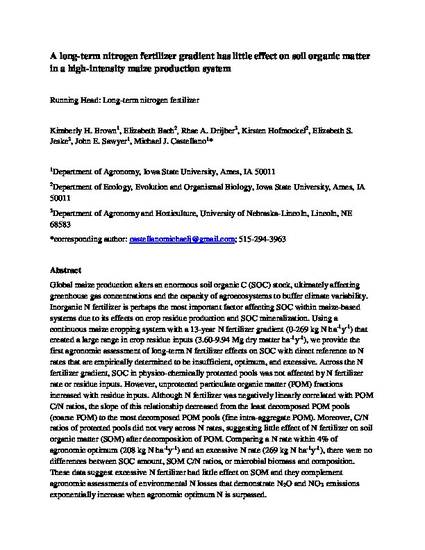
Global maize production alters an enormous soil organic C (SOC) stock, ultimately affecting greenhouse gas concentrations and the capacity of agroecosystems to buffer climate variability. Inorganic N fertilizer is perhaps the most important factor affecting SOC within maize-based systems due to its effects on crop residue production and SOC mineralization. Using a continuous maize cropping system with a 13 year N fertilizer gradient (0–269 kg N ha−1 yr−1) that created a large range in crop residue inputs (3.60–9.94 Mg dry matter ha−1 yr−1), we provide the first agronomic assessment of long-term N fertilizer effects on SOC with direct reference to N rates that are empirically determined to be insufficient, optimum, and excessive. Across the N fertilizer gradient, SOC in physico-chemically protected pools was not affected by N fertilizer rate or residue inputs. However, unprotected particulate organic matter (POM) fractions increased with residue inputs. Although N fertilizer was negatively linearly correlated with POM C/N ratios, the slope of this relationship decreased from the least decomposed POM pools (coarse POM) to the most decomposed POM pools (fine intra-aggregate POM). Moreover, C/N ratios of protected pools did not vary across N rates, suggesting little effect of N fertilizer on soil organic matter (SOM) after decomposition of POM. Comparing a N rate within 4% of agronomic optimum (208 kg N ha−1 yr−1) and an excessive N rate (269 kg N ha−1 yr−1), there were no differences between SOC amount, SOM C/N ratios, or microbial biomass and composition. These data suggest that excessive N fertilizer had little effect on SOM and they complement agronomic assessments of environmental N losses, that demonstrate N2O and NO3 emissions exponentially increase when agronomic optimum N is surpassed.
Available at: http://works.bepress.com/castellano-michael/31/

This is an article from Brown KH, Bach EA, Drijber RA, Hofmockel K, Jeske ES, Sawyer JE, Castellano MJ. 2014. A long-term N fertilizer gradient has little effect on soil organic matter in a high-intensity maize production system. Global Change Biology doi: 10.1111/gcb.12519. Posted with permission.